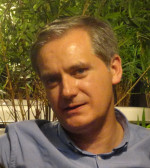Adequate planning and deployment of natural resources reserves such as water and fossil fuels are critical for planning of our society’s activities, for minimizing risks and exposure to natural atmospheric phenomena, and in worst cases even to quickly react to disasters. Information in the form of weather prediction and modeling is at the core of the efficient management of infrastructures as recognized by the investments nations have made in national atmospheric and weather prediction research centers. Invariably, these centers rely on the power of large-scale computing systems with which scientists and engineers model natural phenomena using a plethora of simulation models, sensory data, and sophisticated algorithms.
The algorithms involved in climate modeling and weather predictions are very complex and computationally demanding as they operate over large domains requiring high resolutions or very long integration times thus exacerbating the need for high-performance resources so that accurate estimates can be found in useful time (a weather prediction for tomorrow is hardly useful if it requires more than 24 hours to compute). Improving prediction quality and accuracy requires higher resolution models found by exploring a wide range of its parameters. This is a daunting and error-prone process, demanding even more computing power.
In this workshop we will discuss the many technical challenges related to the computational aspects related to climate modeling and weather prediction, namely:
Programmatically, half of the workshop will be devoted to a comprehensive introduction to climate models and weather prediction, where the audience will be exposed to basic definitions, key concepts, abstractions, design flows, and design constraints; also some highly visible research projects will be presented as exemplars to provide an overview of existing and emerging solutions in this domain. The other half of the event will create a forum for interactive discussion and exchange of ideas and experiences between researchers through posters and demonstrations, with the goal of highlighting details on applicability, performance, and strengths of current solutions. Our aim is for attendees to learn about emerging computing techniques, highlight publicly available modeling and simulation tools, and view directions for longer-term research.
This workshop will bring together researchers and scientists to discuss and exchange their experiences regarding the many challenges related to the computational aspects related to climate modeling and weather prediction. The complexity of the development and maintenance of the programming sources for climate modeling and weather prediction models and the use of domain-specific languages (DSLs) in this domain, relate to virtually any other application domain such computational-fluid dynamics where turbulent flow also plays a key role. As such, the techniques and programming approaches to be discussing in this workshop are, we believe, of interest to researchers and practitioners in other areas.
| 9:20 - 9:30 | OPENNING SESSION (by Haroldo Velho and João MP Cardoso) |
|---|---|
| 9:30 - 10:15 | KEYNOTE (CHAIR: João MP Cardoso, Univ. of Porto and INESC TEC, Portugal) |
“How will weather and climate prediction cope with future computing challenges” |
|
| 10:15 - 11:00 | COFFEE BREAK |
| 11:00 - 12:30 | INVITED SPEAKERS - SESSION 1 (CHAIR: Haroldo Velho, INPE, Brazil) |
“AutoTuning and Adaptivity appRoach for Energy efficient eXascale HPC systems: The ANTAREX Approach” |
|
“Reconfigurable acceleration of earth system modelling” |
|
| 12:30 - 14:00 | LUNCH |
| 14:00 - 15:30 | INVITED SPEAKERS - SESSION 2 (CHAIR: Jorge Barbosa, Univ. of Porto, Portugal) |
“HPC Studies for atmospheric prediction models: BRAMS and OLAM” |
|
“Earth Sciences from a computational point of view: The BSC Earth Sciences experience” |
|
| 15:30 - 16:00 | COFFEE BREAK |
| 16:00 - 17:30 | INVITED SPEAKERS - SESSION 3 (CHAIR: Jan Martinovic, IT4l, Czech Republic) |
“Data assimilation by FPGA for geo-physical dynamical model” |
|
“Research activities at Global Change Research Institute AS CR.” |
|
| 17:30 - 18:30 | DISCUSSION ABOUT PROJECT PROPOSALS AND FINAL REMARKS (CHAIRS: Haroldo Velho and João MP Cardoso) |
| 18:30 - 18:40 | CLOSING SESSION (by Haroldo Velho and João MP Cardoso) |

João M.P. Cardoso < jmpc@acm.org >
University of Porto, FEUP and INESC TEC, Porto, Portugal
TITLE: "AutoTuning and Adaptivity appRoach for Energy efficient eXascale HPC systems: The ANTAREX Approach"
ABSTRACT
The main goal of the ANTAREX project is to express by a Domain Specific Language (DSL) the application self-adaptivity and to runtime manage and autotune applications for green and heterogeneous High Performance Computing (HPC) systems up to the Exascale level. Key innovations of the project include the introduction of a separation of concerns between self-adaptivity strategies and application functionalities. The DSL approach will allow the definition of energy-efficiency, performance, and adaptivity strategies as well as their enforcement at runtime through application autotuning and resource and power management.
Short Bio: João M. P. Cardoso received a 5-year Electronics Engineering degree from the University of Aveiro in 1993, and an MSc and a PhD degree in Electrical and Computer Engineering from the IST/UTL (Technical University of Lisbon), Lisbon, Portugal in 1997 and 2001, respectively. He is currently Associate Professor at the Department of Informatics Engineering, Faculty of Engineering of the University of Porto, Porto, Portugal and a research member of INESC TEC. Before, he was with the IST/UTL (2006-2008), a senior researcher at INESC-ID (2001-2009), and with the University of Algarve (1993-2006). In 2001/2002, he worked for PACT XPP Technologies, Inc., Munich, Germany. He has been involved in the organization of various international conferences. He was general Co-Chair of IEEE/IFIP EUC’2015 and IEEE CSE’2015, General Chair of FPL’2013, General Co-Chair of ARC’2014 and ARC’2006, Program Co-Chair of ARCS’2016, DASIP’2014, and RAW’2010. He served as a Program Committee member for many international conferences. He is co-author of one Springer book, co-editor of two Springer Books and four Springer LNCS volumes. He has (co-)authored over 150 scientific publications (including journal/conference papers and patents) on subjects related to compilers, embedded systems, and reconfigurable computing. He is the technical manager of the H2020 FET-HPC project ANTAREX. He has participated in a number of research projects: as co-scientific coordinator of the FP7 EU-funded project REFLECT (2010-2012), and as coordinator of a number of national funded projects. He is a senior member of IEEE, a member of IEEE Computer Society, and a senior member of ACM. His research interests include compilation techniques, domain-specific languages, reconfigurable computing, application-specific architectures, and high-performance computing with a particular emphasis in embedded computing.

Haroldo F. Campos Velho
< haroldo@lac.inpe.br >
National Institute for Space Research (INPE), Brazil
Senior Researcher: data assimilation, inverse problems, scientific computing, parallel processing
TITLE: "Data assimilation by FPGA for geo-physical dynamical model"
ABSTRACT
Data assimilation (DA) is an essential issue to identify the best initial condition for the numerical weather prediction (NWP). DA is a process to combine observations with data from a mathematical model. Numerical weather prediction (NWP) uses atmospheric general circulation models (AGCMs) to predict the atmospheric dynamics based on current weather conditions. Several techniques were developed to perform data assimilation, as 3D or 4D variational method, Kalman filter, and particle filter. The Local Ensemble Transform Kalman Filter (LETKF) is a variant of particle filter, with Gaussian assumption. However, the mentioned schemes have high computational effort. Here, the LETKF is emulated by Multilayer Perceptron neural network, where an optimal configuration for the NN is obtained by solving an optimization problem by MPCA. The NN is codified in the FPGA. The NN for data assimilation is applied to two AGCMs: SPEEDY, and FSU models. The NN shows good results. However, the approach is much faster than the LETKF.
Short Bio: Haroldo F. Campos Velho is a sênior researcher at National Institute for Space Research (INPE, Brazil), he received hir B.S. in Chemical Engineering from PUC-RS, a M.Sc. (emphasis on physics of nuclear reactors) and a DSc. (emphasis on computational fluid dynamics) in Mechanical Engineering from the UFRGS. Professor of the University of Caxias do Sul (UCS), 1987-1988. He was a visiting scientist at the Istituto di Cosmo-Geofisica (Turin, Italy) and the Department of Atmospheric Science at the Colorado State University (CSU, USA) in 1997 and 1998, respectively. He was head of the Associated Laboratory for Computing and Applied Mathematics (LAC) – 2001-2004, and Associate Director of Space and Environment INPE – 2008-2010. He was elected as a Council member of the Brazilian Society for Computational and Applied Mathematics (SBMAC: 2005-2007). He is currently the President of the PanAmerican Association of Computational Interdisciplinary Science (PACIS).

Sabrina B. M. Sambatti
< sabrinabms@gmail.com >
National Institute for Space Research (INPE), Brazil
PhD student: data assimilation with neural netwoks
TITLE: "Data assimilation by FPGA for geo-physical dynamical model"
ABSTRACT
Numerical weather prediction (NWP) uses atmospheric general circulation models (AGCMs) to predict the atmospheric dynamics based on current weather conditions. Data assimilation (DA) is an essential issue to identify the best initial condition for the numerical weather prediction. DA is a procedure to combine observations with data from a mathematical model. Several techniques were developed to perform data assimilation: 3D or 4D variational method, Kalman filter, and particle filter are good examples. The Local Ensemble Transform Kalman Filter (LETKF) is a variant of particle filter, with Gaussian assumption. However, the mentioned schemes have high computational effort. Here, the LETKF is emulated by multilayer perceptron neural network (NN), where an optimal configuration for the NN is obtained by solving an optimization problem by MPCA. The NN is codified in the FPGA. The NN for data assimilation is applied to two AGCMs: SPEEDY, and FSU models. The NN shows good results. However, the approach is much faster than the LETKF.
Short Bio: Sabrina Bergoch Monteiro Sambatti is graduated in Computer Technology from the University of Paraiba Valley (Univap, 1994), a M.Sc. in Applied Computing from the National Institute for Space Research (INPE, 2004). She was was employed in the support area of the Embraer company (2005-2010). Currently is a doctoral student in Applied Computing (National Institute for Space Research: CAP-INPE). Her research is focusing on High Performance Computing, acting on the following topics: parallel computing, FPGA, optimization algorithms, inverse problems.

Carla Osthoff
< osthoff@lncc.br >
National Laboratory for Scientific Computing (LNCC), Brazil
Researcher: high performance and scientific computing
TITLE: "HPC Studies for atmospheric prediction models: BRAMS and OLAM"
ABSTRACT
There are two kinds of atmospheric prediction models, according to the application domain: global (entire Earth) and regional. For the current resolution (computing power limitation), Global models cannot represent very well the scale of regional weather phenomena. Regional models have higher resolution but are restricted to limited area domains, requiring previous execution of global models. An efficient parallel version is presented of a regional model and a global model using unstructured grid. BRAMS (Brazilian Developments on the Regional Atmospheric Modeling System) is regional-scale model, developed at INPE / CPTEC (National Institute for Space Research / Center for Weather Forecasts and Climate Studies). Several changes were introduced in BRAMS for a better description of tropical processes including the precipitation, land/surface interaction, and the role of aerosols/radiation. Another important feature introduced in BRAMS was a very efficient parallel implementation with MPI. The latter cited strategy is based on domain decomposition, where the atmosphere state advancement of each domain partition is assigned to a different MPI process. The other model is the Ocean-Land Atmosphere Model (OLAM), with regional grid refinement – similar resolution to limited area models on the interested region. This feature allows simultaneous representation (and forecasting) of both scales global and local, as well as bi-directional interactions between scales. The Brazilian collaboration on OLAM and BRAMS is described for recent research studies in HPC clusters in order to provide scalability to the models.
Short Bio: Carla Osthoff is a researcher at National Laboratory for Scientific Computing (LNCC-Brazil), she received her B.S. in Electronics Engineering from PUC-RJ, a M.S. and a Ph.D. in Computer Science from COPPE / UFRJ. She was part of the hardware engineer research group at the Brazilian Center for Physics Research (CBPF/ Brazil), participating in the development of multiprocessors parallel systems with Fermilab/ USA from 1986 to 1996. Her research interests are in the areas of cluster computing, hybrid computing with CPU/GPU, high performance scientific computing applications and parallel programming. Is currently the coordinator from LNCC High Performance Computing Center, from LNCC GPU Computing Research and Teaching Center and several LNCC High Performance Computing Research collaboration projects. See Google Scholar for citations.

Kim Serradell
< kim.serradell@bsc.es >
Barcelona Supercomputing Center, Spain
Co-manager of the Computational Earth Science (CES) group
TITLE: "Earth Sciences from a computational point of view: The BSC Earth Sciences experience"
ABSTRACT
The Computational Earth Sciences group in the Earth Sciences department
at the Barcelona Supercomputing Center is a crescent group which main
goal is to make optimal use of cutting-edge HPC and big data
technologies to increment the efficiency, portability and
user-friendliness of Earth system models, including the pre- and
post-processing of weather, atmospheric chemistry and climate model
data. In order to keep an efficient use of the variety of computing
resources available at the BSC and at other HPC facilities, a solid
software development, profiling and optimisation area has been created.
It provides feedback to Earth system modellers around Europe on how to
improve their codes in the race towards exascale computing. In this
talk, we will present, with specific examples, how the interaction with
the other scientific groups of the department (Climate Prediction and
Atmospheric Composition) and the application of computer sciences
research has been essential to improve the efficiency in the usage of
resources.
Short Bio: Msc. Kim Serradell Maronda, male, is Bachelor (2005) in Computer Sciences for the Facultat d'Informàtica de Barcelona (FIB-UPC) and for the Grande école publique d'ingénieurs en informatique, mathématiques appliquées et télécommunications de Grenoble (ENSIMAG). Since 2014 is also Master on HPC from the (FIB-UPC). Currently, he is the co-manager of the Computational Earth Science (CES) group at the Earth Sciences department in the Barcelona Supercomputing Center (BSC). In the last years, he has been in charge of the computational resources of the department and he was also responsible of the operational runs of the NMMB/BSC-Dust model for the Barcelona Dust Forecast Center and CALIOPE Air Quality System. He's involved in European projects like IS-ENES2, ESiWACE, SDS-WAS, BDFC or PRIMAVERA.

Wayne Luk
< wl 'at' doc.ic.ac.uk >
Department of Computing - Imperial College London, UK
TITLE: "Reconfigurable acceleration of earth system modelling"
ABSTRACT
The increasing adoption of reconfigurable technologies in data centres has led to
growing interest in their capabilities in providing energy-efficient solutions to
demanding computations. This talk presents recent research on computational
acceleration of earth system modelling based on reconfigurable technologies,
targeting dataflow engines containing field programmable gate arrays. The topics
covered include development methods involving architectures and precision
analysis for modelling atmospheric variables with chaotic behaviour, and for
finding the solution of global shallow water equations. This work is based on
research collaboration between Imperial College, University of Oxford and
Tsinghua University.
Short Bio: Wayne Luk is Professor of Computer Engineering at Imperial College London, and the Director of the EPSRC Centre for Doctoral Training in High Performance Embedded and Distributed Systems. He was a Visiting Professor at Stanford University. His current research interests include theory and practice of customizing hardware and software for specific application domains such as climate modelling and genomic data analysis, and high-level compilation techniques and tools for high-performance computers and embedded systems. He is a fellow of the Royal Academy of Engineering, the IEEE and the BCS. He is a recipient of the Research Excellence Award from Imperial College London, and 15 awards for his publications from various international conferences. Three of his papers have been selected to be among the 27 most significant papers from the last 25 years of the FPL conference.

Petr Stepanek
< stepanek.p@czechglobe.cz >
Global Change Research Institute (CzechGlobe), Czech Academy of Sciences, Czech Republic
TITLE: "Research activities at Global Change Research Institute AS CR"
ABSTRACT
GCRI is a public research institution, European center of excellence investigating the ongoing global change and its impact on the atmosphere, biosphere and human society through the use of the latest techniques and instrumentation. The research focuses primarily on the development of climate and its future scenarios, on the carbon cycle and the effects of changing conditions on the production and biodiversity of ecosystems and on the impacts on the future development and behavior of our society. The integral part of CzechGlobe are activities aiming at the development of innovation technological processes, proposals of measures for adaptation and educational activities.
In this contribution we present selected tasks of our team - Sector of Climate Analysis and Modelling: processing of RCM data – analysis of climate change for Central Europe (based on Euro-CORDEX simulations, klimatickazmena), study of urban heat island (urbanadapt), drought monitoring and forecast for Central Europe (intersucho), processing of NWP model outputs - applications for energy sector, etc.
Short Bio: Petr Stepanek gained Ph.D. in physical geography at Masaryk University, Brno, Czech Republic. Since 2003 he was employed at Czech hydrometeorological institute, since 2005 he became head of the Department of Meteorology and Climatology at the regional office. From 2011 he works at Global Change Research Institute, Czech Academy of Sciences, since 2013 in full-time job as senior researcher. His scientific activities are homogenization and quality control of the climatological data, administration of climatic databases and analysis of the data (both spatial and temporal) as well as climate variability. He is author of the software package for homogenization and processing of climatological data (climahom). He also devotes to post-processing of regional climate model outputs (statistical downscaling, validation and correction of regional climate models).

Dr. Peter Bauer
European Centre for Medium-Range Weather Forecasts (ECMWF), Reading, UK
Coordinator of the FET-HPC H2020 Project: ESCAPE - Energy-efficient SCalable Algorithms for weather Prediction at Exascale
TITLE: "How will weather and climate prediction cope with future computing challenges"
Short Bio: Dr. Peter Bauer, a German national, is the deputy director of research at the European Centre for Medium-Range Weather Forecasts (ECMWF) in Reading, UK. He obtained his masters and PhD degrees in meteorology from the universities in Cologne and Hamburg, respectively. Before joining ECMWF, he was leading a research team working on satellite meteorology at the German Aerospace Center (DLR). His background covers physical modelling, data assimilation and satellite remote sensing. During his career, he was awarded research fellowships by UCAR and DLR to work at NOAA and NASA in the US and at IPSL in France. He is the author and co-author of over 100 peer-reviewed scientific journal papers and book chapters and a member of several international scientific advisory committees for DWD, WMO, ESA, and EUMETSAT. At ECMWF, his current duties include the management of the recently launched Scalability Programme, he coordinates the Horizon 2020 project Energy-efficient Scalable Algorithms for Weather Prediction at Exascale (ESCAPE) and co-coordinates the Horizon 2020 centre of Excellence in Simulation of Weather and Climate in Europe (ESiWACE).
For Information about how to register to the workshop, please contact João MP Cardoso (jmpc@fe.up.pt)
Faculdade de Engenharia da Universidade do Porto (FEUP)
Street Dr. Roberto Frias, Postal Code 4200-465 - Porto, PORTUGAL
Electrotecnia Building
Room l-105 (ground-floor)
GPS: 41°10'40.8"N 8°35'52.8"W
How to get to FEUP
We suggest you take the metro to get to FEUP. FEUP is served by the D line of Metro (yellow
line) and is located in the C6 zone. The D line connects the University Pole, where FEUP is
located, to the Town Hall of Gaia in 15 minutes, passing through the “Trindade” metro station,
where it has connection with lines A (blue), B (red), C (green) and E (violet). To get to FEUP you
must get off the metro at the “IPO” metro station (see the image below), go around the
“Campus S. João” Shopping Center, and take the long street (“Rua do Doutor Plácido da Costa”)
to its end. Then, you must cross the “Rua do Doutor Roberto Frias” road and you are at FEUP!